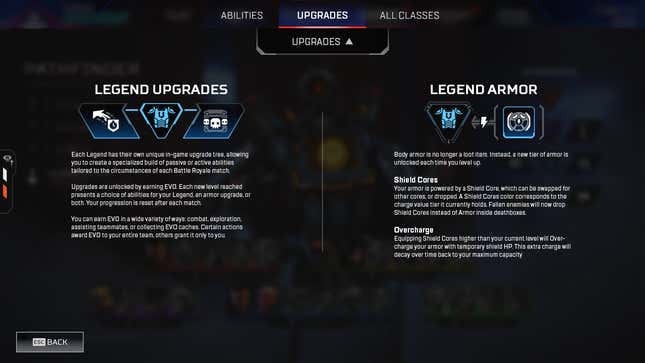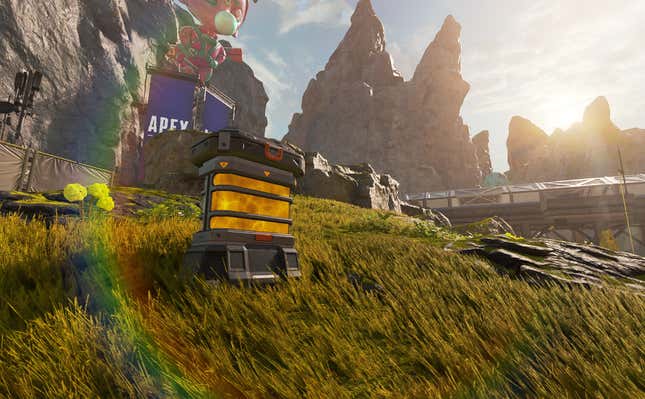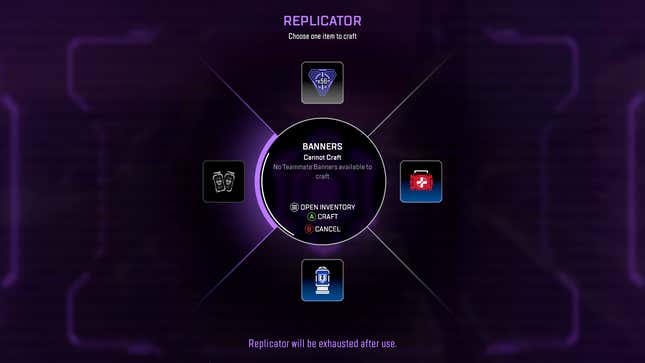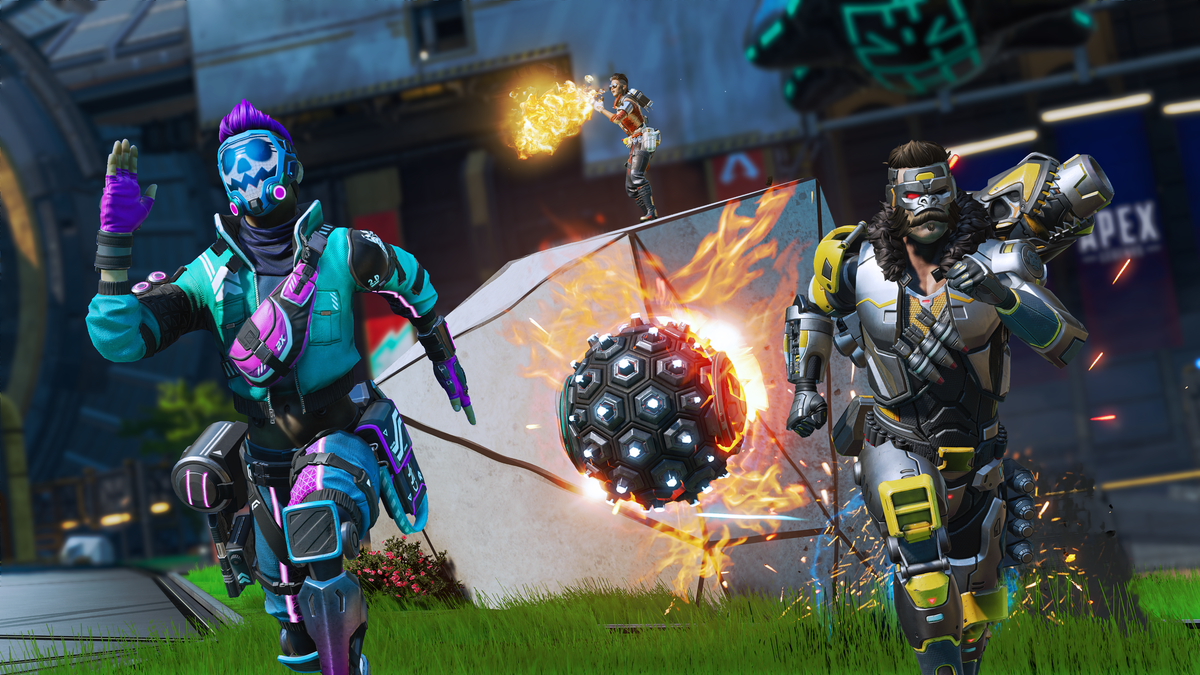Five years after its surprise-launch and subsequent success, the team behind Apex Legends is not afraid to change up its formula. So when season 20 aka Breakout debuts later this month, developer Respawn will dramatically adjust aspects of the battle royale’s gameplay in the hopes that these changes will both nurture Apex’s existing player base and make it more welcoming for newcomers.
The two biggest changes coming in Apex Legends season 20 are an in-match upgrade system, which affords each Legend their own unique perks and abilities to choose from, and a complete rework of the game’s armor system—which includes the removal of armor from the game’s loot pool. There are also changes to and new inclusions within the Evo system, which lets players earn higher armor through in-game actions. The adjustments may seem a little overwhelming, but once you know how these changes will play out and why Respawn felt it necessary to implement them, it should make more sense. Hell, maybe you’ll even agree with them.
Let’s get into all the major Apex Legends season 20 changes.
Apex Legends season 20 armor changes
Armor has always been a major point of contention in Apex Legends. Like most battle royales, a traditional Apex match involves a large number of players dropping onto a map and scouring it for the highest-tier loot, of which armor is a staple. But the randomness (or RNG) of where the best armor is can often lead to unfair matches, with teams grabbing the strongest armor straight out of the gate and laying waste to those with base-level armor.
Read More: EA Lays Off Over 200 Apex Legends Testers Over Zoom Call
Back in 2020, Respawn made a major adjustment to the system, changing it so that every piece of armor in the game was Evo armor, which can be leveled up through in-game actions (kills, knockdowns, assists, and more). This means players have a better chance to get that higher-tier armor if they can’t find it, though it does still favor those who are more aggressive in their approach, as lone wolves can splinter off, get a bunch of kills, and end up with the highest-tier armor (red) early on in the match.
But the armor problem persisted, in large part due to the aforementioned RNG—sure, you could earn your way to red armor, but you could also just find it and avoid engaging in a few firefights to try and gain that added protection. Respawn doesn’t want players to feel like their matches are at the whim of Lady Luck, so the studio is removing armor from the loot pool entirely in Season 20 and removing the ability to upgrade it via Apex Legends’ crafting system. Now, you can only earn that higher armor, rather than stumble upon it or pay to level it up—and even if you pick up higher-tier armor from enemies’ death boxes, the bonus armor is temporary. If you haven’t earned it, you can’t enjoy the fruits of someone else’s labor for too long.

When Respawn first announced this change during an in-person preview that I attended, myself and a few others worried that it would favor seasoned, aggressive players, while simultaneously removing the ability for those players to help newbies. The old armor system meant that veteran players could shepherd, or backpack, new players by leveling up EVO armor and dropping it for them to pick up, giving them a better shot at surviving firefights with enemy squads while they’re still getting their sea legs. With the armor changes coming to Breakout, trading armor won’t matter thanks to the temporary nature of the boost, so veteran players can’t shepherd newbies.
Now, you have to earn that higher armor, which traditionally favored more aggressive, competent players. But after I went hands-on with Apex Legends Season 20, I realized that Respawn has gone to great lengths to ensure that these armor changes have broad appeal. The speed at which you can upgrade your armor and the breadth of activities that earn you points towards those upgrades feels fair and balanced. Sure, you can no longer get a high-level piece of armor handed to you that will last the entire match, nor can you buy your way to higher-level protection, but leveling armor is now much easier. You can earn points from helping your teammates up, or scanning areas, or even getting a few pot-shots in from afar while your more aggressive, learned teammate pushes in close. There are plenty of ways to level up your armor that don’t just support veteran players.
And then there’s the Legend upgrade system, a major pillar in Respawn’s new game design philosophy.

Apex Legends season 20 Legend upgrades
The Legends upgrade system—which I couldn’t help but compare to the once-promised Overwatch 2 skill tree when I first heard about it—is directly tied to Evo progression. As you earn points and level up your armor, you’ll unlock a suite of upgrades that are unique to every Legend. When you reach level two armor, you’ll get a choice between two perks.
Wraith players, for example, can choose between a shorter cooldown for her tactical ability, or an upgrade to her passive ability that alerts players when enemy squads approach them. Reaching level three affords another choice: a shorter cooldown for her ultimate ability, or a faster wind-up on her tactical. There is no Legend upgrade available at armor level 4; reaching that will just unlock the highest-tier armor in the game.
Every Legend has a unique set of upgrades—Mad Maggie’s wrecking ball can be lit on fire, Wattson can deploy two smaller protective pylons rather than one, etc. Not only do these upgrades drastically change the way characters are played, but they also mean that players will have to readjust their approach when it comes to team composition.

Apex Legends season 20 Evo changes
But how does tying Evo armor to Legend upgrades help less experienced gamers, if you’re still required to progress up the ladder, and now have to do so without any help from more experienced players? Well, Respawn has adjusted how you can earn points in each match, broadening the scope so that all kinds of players are rewarded for how they play the game.
Sweaties can still earn points by getting kills and knockdowns, but players can also harvest Evo from new structures scattered around the map (which doles out points for the entire squad), and gain Evo for doing more than just killing. Class-specific actions, reviving downed teammates, and respawning players will help you climb the ladder faster.
According to Respawn, this new Evo system allows for “more flexible ways to support the team other than swapping armors and farming.” Though I was still skeptical of these changes, it took just a few rounds of a season 20 preview for Respawn to sell me on them. I leveled up at a reasonable pace by snagging Evo around the map and doing class-specific actions, and our lobbies were relatively small. I think players will be satisfied with the pace at which they’ll level in a full-scale battle royale match.

Apex Legends season 20 crafting changes
Crafting was first introduced to Apex Legends back in season six (the same season Evo armor became permanent), and it’s gone through several adjustments since then—though the changes to crafting in season 20 dwarf what Respawn has previously done with the mechanic. In what the devs say is an effort to streamline the system and give players “one less thing to juggle,” materials (which were previously used to craft items like armor upgrades and weapon attachments) will be completely removed from the game.
Instead, each player will get to use every replicator (the in-game name for crafting stations) scattered around the map one time, at no cost to them. And they can no longer use replicators to gain armor upgrades or craft weapons or weapon attachments—instead, the replicators will only craft shield batteries, ammo, and med kits.
The speed at which items are crafted has been “dramatically” sped up as well. Historically, using the replicator leaves players incredibly vulnerable, as it takes ten seconds to craft an item and enemies in the area are alerted when a replicator is in-use. Making crafting both faster and free will hopefully encourage more players to use the system.
Apex Legends season 20 loot pool
Apex Legends players usually wait with bated breath for the announcement regarding which weapons will be “jailed” (locked behind crafting) every season, but with season 20, they’ll no longer have to worry. Since replicators will now only craft the three aforementioned items, every single weapon (save for the specialty, heirloom weapons that drop with care packages) is back in the loot pool. R-301 sickos, rejoice.
Those are all the major changes coming to Apex Legends: Breakout when the battle royale’s 20th season drops on February 12.

